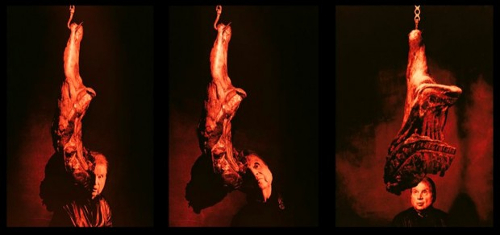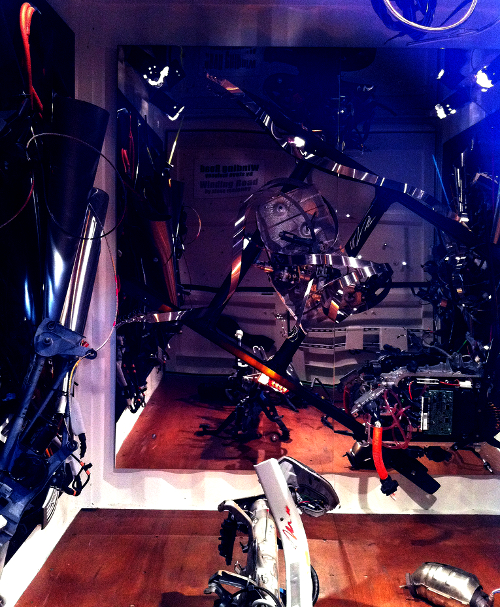Archive for May, 2014
Francis Bacon’s Last Interview, by Francis Giacobetti, 1991-1992

Francis Giacobetti | 1991 | Meat Triptych
“My painting is not violent; it’s life that is violent… Sexuality, human emotion, everyday life, personal humiliation… violence is part of human nature… Even within the most beautiful landscape, in trees, under the leaves the insects are eating each other; violence is part of life.”
Francis Bacon
My first thought on reading this interview has been that we should take real care of the few artists that are able to reflect about this topic. Because there will be always only few of them, and we need them badly, to remember us about what everybody wants to forget.
Here’s the complete article at Aphelis.net “an iconographic and text archive related to art, communication and technology”.
Taken Apart and Put Together: Human, Machine and Sound Technologies
The following is the introduction of an essay entitled “Taken Apart and Put Together: Human, Machine and Sound Technologies”. The title draws on a passage by Donna Haraway. I’ve just completed the essay for an upcoming book on art science, computation and life. The text is also part of my ongoing research into the combination of body theory and machine learning for biophysical musical instruments and performance strategies. In this sense, it gives a glimpse of the path I’m following. Hope the text can give you some ideas. Enjoy the reading…
UPDATE: Added some useful references at the bottom of the article.
One of the unique characteristics of sound lies in that, among all the energy waves that surround us, acoustic waves actively influence the human body at different levels, from intangible emotion arousal to physical induction of resonances, from pleasure and melancholy, to stillness and dance. From another point of view, for the human being sound is sound only when it is heard. It is in our ears that acoustic waves become a discernible event that we can feel, listen to and define as a sound. Because the experience of sound is intrinsically linked to the human body, the performance of music and the design of musical instrument have, for the most, been grounded in body motion. An obvious example is provided by the centuries-old history of traditional musical instrument making. String, wind and percussion instruments are all based on an interaction model whereby the kinetic energy of the human body excite the body of the instrument which then produces sound. With the arrival of analog synthesisers, the role of the human body in the performance of sound technologies shifted from sourcing acoustic energy to the instrument, to controlling its modulation parameters. Switching knobs, plugging and removing electrical cables, or tapping on a switch became understood as another gesture vocabulary. The idea of the body as a means to control sound technologies was then strengthen by the coming of digital computation, in the form of laptop computers and digital music software. Orchestras of ‘virtual synthesisers’ are operated by simply typing on a keyboard and moving a mouse. The performance of laptop music minimises the impact of the player’s physical effort on sound production in exchange for an easy access to a virtually infinite number of musical parameters and operations. With the increasing accessibility of technologies that gather information on a user’s gestural motion, and with the rise on the market of portable devices, the performance of sound technologies have gone through a re-evaluation of the player’s physical engagement in the production of sound. This is the first core concern of this essay.
How to leverage a player’s physical engagement with sound and computational technologies to enable the creation of new sounds and exciting performance strategies?
In which ways can we move beyond a metaphor of control towards an open-ended and mutual mediation of the player and the instrument?
It would be misleading however to discuss the shifting characterisation of the body in the performance of electronic music without adding to the picture the equally mutable characterisation of the body in the cultural milieu. The human body is cultural and political. It is cultural in that it is the active means by which public cultural artifacts are conceived and made. It is political because it is the subject and object of social strategies involving power, ethics and belief. It follows that the cultural understanding of the human body has important, yet often overlooked, repercussions on the understanding of the player’s body in a public musical performance.
Before the establishment of a dedicated field of studies, the body has been discussed as merely an operational part of the overarching structure of society. This approach has prompted a reductive understanding of the human body that have been rendered most notably through the views of essentialism and social constructivism. The former view, indebted with Descartes philosophy of dualism, sees the human being as an entity split between the higher activity of the mind and the lower fleshly mechanisms of the body. Social constructivism on the other hand, sees human beings as individuals whose subjectivity is constructed through the social making of culture. Thereby social constructivism does not account the body nor the world we live in as means of production of the social, but rather as results of it. Public critical discourses addressing directly the body have first arised from the second feminist wave during the ’60s and the ’70s. The feminist critique has addressed the objectification of the female body by a male-dominated power structure. Specifically, a broad public debate has focused on issues like family, sexuality, workplace conditions, and reproductive rights. Since then, a sociology of the body, or body theory have been established. Sociologists, philosophers, and scientists have investigated the body as the site where and through which identity, gender, religion, and knowledge are nurtured. These perspectives have in turn fostered the cultural analysis of the relation between the machine and the human body. Namely, the humanities have elaborated new definitions of what means to be human in the view of the increasingly intimate integration of the human body and machinic, computational, and biological technologies. This is the second core issue of the present work.
How can we discuss critically the integration of man and machine at a cultural and political level?
How can such understanding inform the way we design technological musical instruments and the related performance strategies?
The term ‘integration’ is used above purposely to indicate not a mere pairing of the machine and the human body, but the intermixing of two things that have been long segregated. The integration of the human and the machine is not intended at a metaphysical level, but at a practical one. Biomedical technologies, or biotechs in short, have provided us an entry point to a still largely unexplored territory where human and technological bodies blend together. DNA cells are used to do computations in test tubes, the entire human genome heritage is stored and categorised in digital database accessible via the Web, artificial organs are used to replace malfunctioning human organs, electrical and mechanical signals produced by physiological processes are channeled through the circuits of robotic prosthesis that enable human beings to restore their bodies. This is the result of a long history of research in the field of biomedical engineering and its branches, which include neural, genetic and tissue engineering, medical implants and prosthetics, and biomedical equipment design. Far from wanting to center this work on biomedical engineering, it will be shown how the knowledge produced in that field has been re-appropriated by performance art practice towards the critical questioning of human physicality and biology.
To summarise, the previous paragraphs have mapped out the broad areas of study that this essay will touch upon, namely a) performance of sound technologies, b) body theory, and c) biomedical engineering. Within those areas we have identified the core point of interest that are i) an open-ended and mutual mediation of a player and the instrument that leverages physical engagement, ii) the cultural and political nuances of the integration of human and machine and its relevance to musical instrument design. In order to elaborate a perspective that embraces such diverse topics we will make use of two key concepts: unfinishedness and biomediation. Unfinishedness relates to the incomplete nature of the human being and the ways such nature make us bound to extend our bodies through technologies. Biomediation refers to the intermix of human and machines at the physical and biological level, and to the modalities whereby this extends the expressive capacity of both the human and the technological bodies. In the remainder of this essay we review the origins and most relevant developments of those two key concepts in philosophy and cultural studies, and then discuss their applications in artistic performance, with a special focus on the role of sound technologies.
Some core references the full essay draws upon:
Bedau, M. and P. Humphreys
2008. Emergence: Contemporary Readings in Philosophy and Science. MIT Press.
Braidotti, R.
2013. The Posthuman. Cambridge, UK, Malden, MA, USA: Polity Press.
Clough, P. T.
2008. The Affective Turn: Political Economy, Biomedia and Bodies. Theory, Culture & Society, 25(1):1–22.
Gray, C. H., H. Figueroa-Sarriera, and S. Mentor
1995. The Cyborg Handbook. New York and London: Routledge.
Haraway, D.
2003. The Companion Species Manifesto: Dogs, People, and Significant Otherness. Prickly Paradigm Press.
Hayles, K. N.
1999. How We Became Posthuman: Virtual Bodies in Cybernetics, Literature, and Informatics. University Of Chicago Press.
Massumi, B.
2002. The Evolutionary Alchemy of Reason. In Parables for the Virtual:
Movement, Affect, Sensation. Durham: Duke University Press.
Maturana, H. R. and F. J. Varela
1980. Autopoiesis and Cognition: The Realization of the Living. Springer.
Mulhall, S.
1996. Heidegger and Being and Time. London and New York: Routledge.
Shilling, C.
2012. The Body and Social Theory. Third Edition. Sage Publications Ltd.
Simondon, G.
1992. The Genesis of the Individual. In Incorporations (Zone 6), J. Crary and S. Kwinter, eds., Pp. 297–319. Zone Books.
Stelarc
2002. Towards a Compliant Coupling: Pneumatic Projects, 1998-2001. In The Cyborg Experiments: The Extension of the Body in the Media Age, Pp. 73–77. Bloomsbury Academic
Tanaka, A.
2011. BioMuse to Bondage: Corporeal Interaction in Performance and Exhibition BioMuse. In Intimacy Across Visceral and Digital Performance, M. Chatzichristodoulou and R. Zerihan, eds., Pp. 1–9. Basingstoke: Palgrave Macmillan.
Thacker, E.
2003. What is Biomedia? Configurations, 11(1):47–79.
Turner, B. S.
1992. Regulating Bodies: Essays in Medical Sociology. Taylor & Francis.
Varela, F. J., E. Rosch, and E. Thompson
1991. The embodied mind: Cognitive Science and Human Experience. MIT Press.
Waisvisz, M.
2006a. Panel Discussion moderated by Michel Waisvisz. Manager or Musician? About virtuosity in live electronic music. In International Conference on New Interfaces for Musical Expression, May, p. 415, Paris, France.


